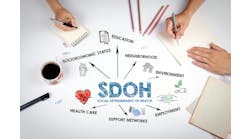What does it mean to rethink a long-held paradigm? In the case of leaders from UnitedHealthcare (UHC), it means a lot of thought, a lot of planning, and a lot of work. But unlocking the potential in truly harnessing social determinants of health data to support improved care management and population health management work was the objective, and so leaders of the Minnetonka, Minn.-based health plan, which serves nearly 42 million members nationwide, went to work.
The goal? To create the first-of-its-kind, industry-wide model that would standardize and integrate consumer self-identified social determinants of health (SDOH) barriers allowing for referral assistance and outcome measurement at scale. With that goal in mind, UHC leaders in 2017 began a nationwide initiative to capture, code, and refer to social/governmental programs members who self-identified SDOH. The work began with UHC’s Medicare Advantage (MA) consumers, but the model is applicable for any consumer, and in 2019 UHC is expanding this work to its Medicaid and commercial members. And it is for this broad-based, potentially transformative effort to incorporate social determinants data into clinical workflow in order to enhance plan member health status, Healthcare Innovation has awarded the UnitedHealthcare team the third-place award in this year’s Innovator Awards Program.
UnitedHealthcare leaders began SDOH collection with 36 individual codes focusing on members’ most prevalent barriers-to-care determinants. Half of those codes (18) are standard ICD-10-CM diagnosis codes, and the other half (18) are UHC uniquely created “member attribution codes.” These codes augment the ICD-10-CM codes where specific granularity was required, and not available in the ICD-10-CM code set. Collecting and using these codes together allows for improved care that better integrates member health and social factors into the holistic care of the member.
Sheila Shapiro, senior vice president, national strategic partnerships; Bill Hagan, president, UnitedHealthcare Clinical Services; and Richard Migliori, M.D., chief medical officer, UnitedHealthcare, have been leading the initiative.
“At the core of why we launched this initiative—and this is one of many—is our mission statement, which is to help people live healthier lives,” Hagan says. “And that combines with what we do with Optum [a data anlaytics-focused brand within UnitedHealthGroup, UHC’s parent company] to help the healthcare system work for everyone. It speaks to the Triple Aim, and to our mission. We see the healthcare system today in the state it’s in, with increasing costs and without the quality outcomes we’d like to see; and wherever we get the data and information from, we realize we could do better. And the Robert Wood Johnson Foundation notes that 80 percent of what affects a person’s health occurs outside the doctor’s office.”
What’s more, Hagan says, “As we started working with our Medicare population and expanded the work into our Medicaid population, we saw that the social determinants, including around housing, poverty and nutrition, were very important in all this. A lot of reasons people aren’t medication-adherent or aren’t getting to their dialysis appointments; and there are major issues around homelessness and financial income factors. At a very high level, that’s what’s driving us to try to be better at really helping people improve their health, and making the system better.” As a result, Hagan explains, the team began seven years ago to lay the foundations for this program and others.
“We knew that in order for this kind of data to be in the ecosystems, and to start to incorporate social and governmental services into our thinking, it had to be a very practical application of concepts—not a brand-new system or new tool, but a way for us to expand what exists today, because that ties into the physicians’ workflow,” Shapiro says. “And if we’re not thinking about how to make it not only simply for consumers, but also easier for physicians to practice medicine, we felt like we were going to be missing a key element.” And that’s where the key to this initiative came in: Shapiro, Hagan, Migliori, and their colleagues realized that they needed to standardize these SDOH data elements, and connect them with the diagnosis and patient visit documentation processes. “As we started thinking about other factors impacting health, we began to think about an infrastructure; and that’s where the ICD-10 codes formed the basis for a model,” Shapiro says. “When you go to a doctor, they diagnose you and then refer you to a pharmacy or specialist, and that’s a referral, essentially; and the third step is the fulfillment of that service, if the consumer avails themselves of that referral. That’s how the system works today, and our systems are built to incorporate those steps. So rather than creating a new system or a tool that sits outside that system, it’s leveraging the existing system and magnifying its use.”
As a result, UHC leaders began their SDOH collection with 36 individual codes, with 18 of those codes being UHC-created “member attribution codes” that weren’t available in the ICD-10 code set.
“One of the things we found when we began this process was that the work of determining social determinants was occurring in our organization at a very high volume, but there was no voice to that work, because there was no standardized language,” Shapiro says. “We’ve been making referrals for our Medicare population for over five years, so it’s not new work; but there was no way to bring it into the ecosystem of the payer-provider environment. So where referrals were already being made, we took as the basis of our coding project. So we worked with a certified biller and a medical director within one of our organizations within Optum, and we mapped every type of service, to match acceptable billing practice. And that was critical, because we’re using existing diagnosis codes; and there are many providers currently using those particular 18 codes, which mapped most directly to the work we had on record.”
In practice, Shapiro explains, “We created a member attribution code, in lieu of an ICD-10 code. And we want this to be an industry solution, not just a United solution. It ties into our sense of mission. That’s why we made the recommendation at the end of the submission—we got endorsements from major organizations that have influence in the industry, like NCQA, and the National Association of Community Health Centers (NACHC), and then went to a state regulator of Medicaid that really is on the cutting edge for Medicaid. That’s the Arizona Health Care Cost Containment System (AHCCCS)—and they all liked it—and we submitted the app, for a total of 23 codes that we had created, to all those organizations, for input, and then we submitted the recommendation to the ICD-10 Committee.” In other words, as of the time of publication of this article, 23 codes have been created and shared with the above-mentioned organizations for input.
Speaking as a physician who practiced clinically for 15 years before going into medical management, Migliori says, “What you don’t want to do is to put a whole bunch of burdens on people, or overwhelm them with coding and documentation, adding in one more thing for clinicians to do; it’s important to be really smart about this.” That’s how all the potential codes ended up being consolidated into 23 “member attribution codes” that the UnitedHealthcare team could agree would be most useful to create, for care management and population health management purposes. “While there are all kinds of capabilities for managing data, one thing that drives the system is the diagnostic codes; and doctors always look at them,” Migliori notes. “We wanted to be less intrusive and more part of their workflow, so that it’s not a distraction, but rather an assistance. And the final thing has to do with getting people to use them; they become their own reward over time.” What’s more, he notes, care managers, social workers, home healthcare professionals, and other appropriate individuals are now able to use and share SDOH data to improve care management across the continuum. “The most important thing that Sheila’s done,” Migliori says, “is to help build out the community of social support systems, community by community, that can be called on to support the individual.”
In the end, Hagan says, “This work that Sheila’s doing is a piece of our strategy to transform healthcare. I don’t think that anyone has the perfect lock on how to transform healthcare; there are a lot of great ideas out in the marketplace. But as we think about innovative approaches, there are three key ones,” he says: “personalized care and navigation; leveraging our big-data assets to collect clinical data from EHRs [electronic health records] and social-determinant data, to help members navigate the system; and redefining access to care, which looks at the person holistically and thinks about not only a medical network and a behavioral network, but also a social network of social services that can bring together services from across the community.”
If it takes a village to raise a child, then enhancing consumer health through such initiatives as this one, through incorporating social determinants data into care management, looks like a winning strategy for managed healthcare going into the future.




